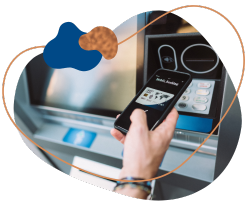Money Management for Teens: How to Stay Safe with Digital Payments
Are you a parent of a teen (or several)? If so, let's just take a second and applaud you. 👏
You've made it so far as a parent and are most likely facing some new challenges now that your child(ren) have hit their teen years. You're a rockstar for pushing through and reading up on topics like these - it shows you really care!
Money management for teens is simple, but not always easy in practice. Watch our news segment on Arizona's Family or read the article below to get some of our money management tips for teens.
Digital Payments 📱
Odds are you're familiar with digital payments. This is the ability to quickly and easily send and receive money through a smartphone or computer using financial apps/services and digital wallets. Think Zelle®, Venmo, CashApp, ApplePay, PayPal, etc.
No surprise here: Teens are early adopters of digital payment solutions because it’s quick and easy. Consider these strategies in teaching them some important lessons in the process.
1. The Value of Money 💸
- The Decision Gap: How long you think about something before actually taking action.
As a teen, the decision gap for making a purchase or paying someone is much shorter than it was 20 years ago. With digital payments, you can send and receive money in seconds. This leads to a very short decision gap and can make teens more likely to give in to impulse purchases (or even the coercion of a scammer).
The fix is to incentivize them to wait, if you can. Perhaps offer a higher allowance or perks in other areas when they pause and consider their decision before making a purchase. It encourages that thoughtful and patient behavior to continue through adulthood - whether you have to wait for a paycheck or need to think through a big purchase to avoid buyer's remorse.
.png?width=316&height=323&name=Teen%20Checking%20(3).png)
- The Pain of Payment: the negative effect consumers experience when they realize they’ve lost financial resources or will lose them in the future.
The lower the pain of payment, the more we spend! Because why not! Right?
Digital payments are not very tangible. It's SO easy. This lower pain of payment can lead to higher spending and financial trouble down the road.
It might be helpful to encourage your teen to use cash in some cases. It can help them physically feel and see their financial resources leaving them. Another option is to implement something that causes that "pain of payment." Potentially an automatic text or push notification of their new account balance after every purchase.
.png?width=338&height=338&name=Digital%20Banking%20Upgrade%20(1).png)
2. Personal Safety
- Public vs Private Notes
If you’re going to put your foot down on money management for teens, this might be the place to do it. Insist that all notes on payments are kept PRIVATE and not PUBLIC. Many payment systems require you to put a note or emoji on the payment to indicate what it’s for, but hackers LOVE these public comments because they can potentially use them to track location, spending habits, and personal details. Scammers love teens who overshare. ‼️ - Never Send Funds to Someone You Don't Know and Trust
It may sound obvious, but in the heat of the moment your teen may not think twice. Teach them how to confirm information and ensure they personally know who they're paying. Digital payments use REAL money, and you can almost never get it back. If you’re scammed, you don’t have the same protections that you have if using a debit or credit card with a trusted financial institution. ⭐

Ready to take your family's identity theft protection to the next level? Our financial tech experts put together a guide to help with that. You can download it for free any time.
We're pretty passionate about money management for teens over here at Copper State Credit Union. Check out some of our other resources for parents of teens:
- Teen Checking Accounts
- Are You Cyber Safe? For Teens
- $5,000 Higher Education Scholarship
- Improve Online Safety with Games
This article is intended to be a general resource only and is not intended to be nor does it constitute legal advice. Any recommendations are based on opinion only. Rates, terms and conditions are subject to change and may vary based on creditworthiness, qualifications, and collateral conditions. All loans subject to approval.

.png)
